Validation of Spatial Prediction Models for Landslide Susceptibility Mapping by Considering Structural Similarity
Abstract
:1. Introduction
2. Description of the Study Area
3. Data and Materials
3.1. Landslide Inventory
3.2. Conditional Factors
4. Methodology
4.1. Preparation of Training and Validation Datasets
4.2. Landslide Susceptibility Modeling
4.2.1. Frequency Ratio Method
4.2.2. Certainty Factor Method
4.3. Model Validation Strategies
4.3.1. Traditional Validation Approaches
4.3.2. Spatially Correlated Validation Approaches
5. Results and Analysis
5.1. Landslide Conditional Factor Analysis
5.2. Model Results and Analysis
5.3. Model Validation and Comparison
6. Discussion and Conclusions
Acknowledgments
Author Contributions
Conflicts of Interest
References
- Corominas, J.; van Westen, C.; Frattini, P.; Cascini, L.; Malet, J.P.; Fotopoulou, S.; Catani, F.; Van DenEeckhaut, M.; Marouli, O.; Agliardi, F.; et al. Recommendations for the quantitative analysis of landslide risk. Bull. Eng. Geol. Environ. 2014, 73, 209–263. [Google Scholar] [CrossRef]
- Ba, Q.Q.; Chen, Y.M.; Deng, S.S.; Wu, Q.J.; Yang, J.X.; Zhang, J.Y. An improved information value model based on gray clustering for landslide susceptibility mapping. ISPRS Int. J. Geo-Inf. 2017, 6, 18. [Google Scholar] [CrossRef]
- Feizizadeh, B.; Roodposhti, M.S.; Jankowski, P.; Blaschke, T. A GIS-based extended fuzzy multi-criteria evaluation for landslide susceptibility mapping. Comput. Geosci. 2014, 73, 208–221. [Google Scholar] [CrossRef] [PubMed]
- Feizizadeh, B.; Blaschke, T.; Nazmfar, H.; Rezaei Moghaddam, M.H. Landslide susceptibility mapping for the Urmia Lake basin, Iran: A multi-criteria evaluation approach using GIS. Int. J. Environ. Res. 2013, 7, 319–336. [Google Scholar]
- Jebur, M.N.; Pradhan, B.; Tehrany, M.S. Optimization of landslide conditioning factors using very high-resolution airborne laser scanning (LiDAR) data at catchment scale. Remote Sens. Environ. 2014, 152, 150–165. [Google Scholar] [CrossRef]
- Tien Bui, D.; Tuan, T.A.; Klempe, H.; Pradhan, B.; Revhaug, I. Spatial prediction models for shallow landslide hazards: A comparative assessment of the efficacy of support vector machines, artificial neural networks, kernel logistic regression, and logistic modes tree. Landslides 2016, 13, 361–378. [Google Scholar] [CrossRef]
- Wang, X.L.; Zhang, L.Q.; Wang, S.J.; Lari, S. Regional landslide susceptibility zoning with considering the aggregation of landslide points and the weights of factors. Landslides 2014, 11, 399–409. [Google Scholar] [CrossRef]
- Ardizzone, F.; Cardinali, M.; Carrara, A.; Guzzetti, F.; Reichenbach, P. Impact of mapping errors on the reliability of landslide hazard maps. Nat. Hazards Earth Syst. 2002, 2, 3–14. [Google Scholar] [CrossRef]
- Conforti, M.; Muto, F.; Rago, V.; Critelli, S. Landslide inventory map of north-eastern Calabria (South Italy). J. Maps 2014, 10, 90–102. [Google Scholar] [CrossRef]
- Ayalew, L.; Yamagishi, H.; Maruib, H.; Kannoc, T. Landslides in Sado Island of Japan: Part II. GIS-based susceptibility mapping with comparisons of results from two methods and verification. Eng. Geol. 2005, 81, 432–445. [Google Scholar] [CrossRef]
- Galli, M.; Ardizzone, F.; Cardinali, M.; Guzzzetti, F.; Reichenbach, P. Comparing landslide inventory maps. Geomorphology 2008, 94, 268–289. [Google Scholar] [CrossRef]
- Vander Jagt, B.J.; Durand, M.T.; Margulis, S.A.; Kim, E.J.; Molotch, N.P. The effect of spatial variability on the sensitivity of passive microwave measurement to snow water equivalent. Remote Sens. Environ. 2013, 136, 163–179. [Google Scholar] [CrossRef]
- Chang, K.T.; Dou, J.; Chang, Y.; Liu, J.K. Spatial resolution effects of digital terrain models on landslide susceptibility analysis. ISPRS-Int. Arch. Photogramm. Remote Sens. Spat. Inf. Sci. 2016, XLI-B8, 33–36. [Google Scholar] [CrossRef]
- Meten, M.; PrakashBhandary, N.; Yatabe, R. Effect of landslide factor combinations on the prediction accuracy of landslide susceptibility maps in the Blue Nile Gorge of Central Ethiopia. Geoenviron. Disasters 2015, 2, 9. [Google Scholar] [CrossRef]
- Wang, L.J.; Sawada, K.; Moriguchi, S. Landslide susceptibility analysis using light detection and ranging-derived digital elevation models and logistic regression models: A case study in Mizunami City, Japan. J. Appl. Remote Sens. 2013, 7, 121–130. [Google Scholar] [CrossRef]
- Pradhan, B.; Lee, S. Landslide susceptibility assessment and factor effect analysis: Backpropagation artificial neural networks and their comparison with frequency ratio and bivariate logistic regression modelling. Environ. Model. Softw. 2010, 25, 747–759. [Google Scholar] [CrossRef]
- Akgun, A.; Sezer, E.A.; Nefeslioglu, H.A.; Gokceoglu, C.; Pradhan, B. An easy-to-use MATLAB program (MamLand) for the assessment of landslide susceptibility using a Mamdani fuzzy algorithm. Comput. Geosci. 2012, 38, 23–34. [Google Scholar] [CrossRef]
- Chung, C.J.; Fabbri, A.G. Probabilistic prediction models for landslide hazard mapping. Photogramm. Eng. Remote Sens. 1999, 65, 1389–1399. [Google Scholar]
- Pradhan, B.; Mansor, S.; Pirastech, S.; Buchroithner, M.F. Landslide hazard and risk analyses at a landslide prone catchment area using statistical based geospatial model. Int. J. Remote Sens. 2011, 32, 4075–4087. [Google Scholar] [CrossRef]
- Thanh, L.; De Smedt, F. Slope stability analysis using a physically based model: A case study from a Luoi district in Thua Thien-Hue province, Vietnam. Landslide 2014, 11, 897–907. [Google Scholar] [CrossRef]
- Chung, C.J.; Fabbri, A.G. Validation of spatial prediction models for landslide hazard mapping. Nat. Hazards 2003, 30, 451–472. [Google Scholar] [CrossRef]
- Remondo, J.; Gonzalez, A.; Diaz De Teran, J.R.; Cendrero, A.; Fabbri, A.; Chung, C.J. Validation of landslide susceptibility maps: Example and applications from a case study in Northern Spain. Nat. Hazards 2004, 30, 437–449. [Google Scholar] [CrossRef]
- Femandez, C.I.; Castillo, T.F.D.; Hamdouni, R.E.; Montero, J.C. Verification of landslide susceptibility mapping: A case study. Earth Surf. Landf. 1999, 24, 537–544. [Google Scholar] [CrossRef]
- Guzzetti, F.; Cardinali, M.; Reichenbach, P.; Carrara, A. Comparing landslide maps: A case study in the upper Tiber river basin, Central Italy. Environ. Manag. 2000, 25, 247–263. [Google Scholar] [CrossRef]
- Fawcett, T. An introduction to ROC analysis. Pattern Recogn. Lett. 2006, 27, 861–874. [Google Scholar] [CrossRef]
- Frattini, P.; Crosta, G.B.; Carrara, A. Techniques for evaluating the performance of landslide susceptibility models. Eng. Geol. 2010, 111, 62–72. [Google Scholar] [CrossRef]
- Mohammady, M.; Pourghasemi, H.R.; Pradhan, B. Landslide susceptibility mapping at Golestan Province, Iran: A comparison between frequency ratio, Dempster-Shafer, and weights-of-evidence models. J. Asian Earth Sci. 2012, 61, 221–236. [Google Scholar] [CrossRef]
- Aghdam, I.N.; Pradhan, B. Landslide susceptibility mapping using an ensemble statistical index (Wi) and adaptive neuro-fuzzy inference system (ANFIS) model at alborz mountains (Iran). Environ. Earth Sci. 2016, 75, 1–20. [Google Scholar] [CrossRef]
- Ozdemir, A.; Altural, T. A comparative study of frequency ratio, weights of evidence and logistic regression methods for landslide susceptibility mapping: Sultan Mountains, SW Turkey. J. Asian Earth Sci. 2013, 64, 180–197. [Google Scholar] [CrossRef]
- Tien Bui, D.; Pradhan, B.; Lofman, O.; Revhaug, I.; Dick, O.B. Spatial prediction of landslide hazards in Hoa Binh province (Vietnam): A comparative assessment of the efficacy of evidential belief functions and fuzzy logic models. Catena 2012, 96, 28–40. [Google Scholar] [CrossRef]
- Van Westen, C.J.; Rengers, N.; Soeters, R. Use of geomorphological information in indirect landslide susceptibility assessment. Nat. Hazards 2003, 30, 399–419. [Google Scholar] [CrossRef]
- Bijukchhen, S.M.; Kayastha, P.; Dhital, M.R. A compressive evaluation of heuristic and bivariate statistical modelling for landslide susceptibility mappings in Ghurmi-Dhad Khola, east Nepal. Arab. J. Geosci. 2013, 6, 2727–2743. [Google Scholar] [CrossRef]
- Dagdelender, G.; Nefeslioglu, H.A.; Gokceoglu, C. Landslide susceptibility model validation: A routine starting from landslide inventory to susceptibility. In Landslide Science for a Safer Geoenvironment; Sassa, K., Canuti, P., Yin, Y., Eds.; Springer: Cham, Switzerland, 2014. [Google Scholar]
- Beijing Geological and Mineral Bureau. The Expedition Report of Regional Geology Survey (Dahuashan Sheet, Pinggu Sheet, 1:50 000); Beijing Geological and Mineral Bureau: Beijing, China, 1995.
- Jimenez-Peralvarez, J.D.; Irigaray, C.; El Hamdouni, R.; Chacon, J. Landslide susceptibility mapping in a semi-arid mountain environment: An example from the southern slopes of Sierra Nevada (Granada, Spain). Bull. Eng. Geol. Environ. 2011, 70, 265–277. [Google Scholar] [CrossRef]
- Yilmaz, I. Landslide susceptibility mapping using frequency ratio, logistic regression, artificial neural networks and their comparison: A case study from Kat landslides (Tokat-Turkey). Comput. Geosci. 2009, 35, 1125–1138. [Google Scholar] [CrossRef]
- Lee, S.; Choi, J.; Woo, I. The effect of spatial resolution on the accuracy of landslide susceptibility mapping: A case study in Boun, Korea. Geosci. J. 2004, 8, 51–60. [Google Scholar] [CrossRef]
- Andreas, A.A.; Lekkas, E. Rockfall susceptibility map for Athinios port, Santorini Island, Greece. Geomorphology 2010, 118, 152–166. [Google Scholar]
- Tien Bui, D.; Lofman, O.; Revhaug, I.; Dick, O. Landslide susceptibility analysis in the Hoa Binh province of Vietnam using statistical index and logistic regression. Nat. Hazards 2011, 59, 1413–1444. [Google Scholar]
- Jenks, G.F. Generalization in statistical mapping. Ann. Assoc. Am. Geogr. 1963, 53, 15–26. [Google Scholar] [CrossRef]
- Tien Bui, D.; Ho, T.C.; Pradhan, B.; Pham, B.T.; Nhu, V.H.; Revhaug, I. GIS-based modeling of rainfall-induced landslides using data mining-based functional trees classifier with AdaBoost, Bagging, and MultiBoost ensemble frameworks. Environ. Earth Sci. 2016, 75, 1101. [Google Scholar] [CrossRef]
- Baillifard, F.; Jaboyedoff, M.; Sartori, M. Rockfall hazard mapping along a mountainous road in Switzerland using a GIS-based parameter rating approach. Nat. Hazards Earth Syst. Sci. 2003, 3, 431–438. [Google Scholar] [CrossRef]
- Ayalew, L.; Yamagishi, H. The application of GIS-based logistic regression for landslide susceptibility mapping in the Kakuda-Yahiko Mountains, Central Japan. Geomorphology 2005, 65, 15–31. [Google Scholar] [CrossRef]
- Yilmaz, C.; Topal, T.; Suzen, M.L. GIS-based landslide susceptibility mapping using bivariate statistical analysis in Devrek (Zonguldak-Turkey). Environ. Earth Sci. 2012, 65, 2161–2178. [Google Scholar] [CrossRef]
- Wu, Y.L.; Li, W.P.; Liu, P.; Bai, H.Y.; Wang, Q.Q.; He, J.H.; Liu, Y.; Sun, S.S. Application of analytic hierarchy process model for landslide susceptibility mapping in the Gangu County, Gansu Province, China. Environ. Earth Sci. 2016, 75, 1–11. [Google Scholar] [CrossRef]
- Chung, C.J.; Fabbri, A.G. Predicting landslides for risk analysis-spatial models tested by a cross-validation technique. Geomorphology 2008, 94, 438–452. [Google Scholar] [CrossRef]
- Lee, S.; Pradhan, B. Landslide hazard mapping at Selangor, Malaysia using frequency ratio and logistic regression models. Landslides 2007, 4, 33–41. [Google Scholar] [CrossRef]
- Pourghasemi, H.R.; Pradhan, B.; Gokceoglu, C.; Mohammadi, M.; Moradi, H.R. Application of weights-of-evidence and certainty factor models and their comparison in landslide susceptibility mapping at Haraz watershed, Iran. Arab. J. Geosci. 2013, 6, 2351–2365. [Google Scholar] [CrossRef]
- Sujatha, E.R.; Rajamanickam, G.V.; Kumaravel, P. Landslide susceptibility analysis using Probabilistic Certainty Factor Approach: A case study on Tevankarai stream watershed, India. J. Earth Syst. Sci. 2012, 121, 1337–1350. [Google Scholar] [CrossRef]
- Lee, S. Application of likelihood ratio and logistic regression model for landslide susceptibility mapping using GIS. Environ. Manag. 2004, 34, 223–232. [Google Scholar] [CrossRef]
- Lee, S.; Talib, J.A. Probabilistic landslide susceptibility and factor effect analysis. Environ. Geol. 2005, 47, 982–990. [Google Scholar] [CrossRef]
- Pradhan, B. Landslide susceptibility mapping of a catchment area using frequency ratio, fuzzy logic and multiple logistic regression approaches. J. Indian Soc. Remote Sens. 2010, 38, 301–320. [Google Scholar] [CrossRef]
- Shortliffe, E.H.; Buchanan, G.G. A model of inexact reasoning in medicine. Math. Biosci. 1975, 23, 351–379. [Google Scholar] [CrossRef]
- Pourghasemi, H.R.; Mohammady, M.; Pradhan, B. Landslide susceptibility mapping using index of entropy and conditional probability models in GIS: Safarood Basin, Iran. Catena 2012, 97, 71–84. [Google Scholar] [CrossRef]
- Chung, C.J.; Fabbri, A.G. The representation of geosciences information for data integration. Non-Renew. Resour. 1993, 2, 122–139. [Google Scholar] [CrossRef]
- Binaghi, E.; Luzi, L.; Madella, P. Slope instability zonation: A comparison between certainty factor and fuzzy Dempster–Shafer approaches. Nat. Hazards 1998, 17, 77–97. [Google Scholar] [CrossRef]
- Swets, J.A. Measuring the accuracy of diagnostic systems. Science 1988, 240, 1285–1293. [Google Scholar] [CrossRef] [PubMed]
- Wang, Z.; Bovik, A.C.; Sheikh, H.R.; Simoncelli, E.P. Image quality assessment: From error visibility to structural similarity. IEEE Trans. Image Process. 2004, 13, 600–612. [Google Scholar] [CrossRef] [PubMed]
- Lee, S.; Min, K. Statistical analyses of landslide susceptibility at Yongin, Korea. Environ. Geol. 2001, 40, 1095–1113. [Google Scholar] [CrossRef]
- Sarkar, S.; Kanungo, D.P. An integrated approach for landslide susceptibility mapping using remote sensing and GIS. Photogramm. Eng. Remote Sens. 2004, 70, 617–625. [Google Scholar] [CrossRef]
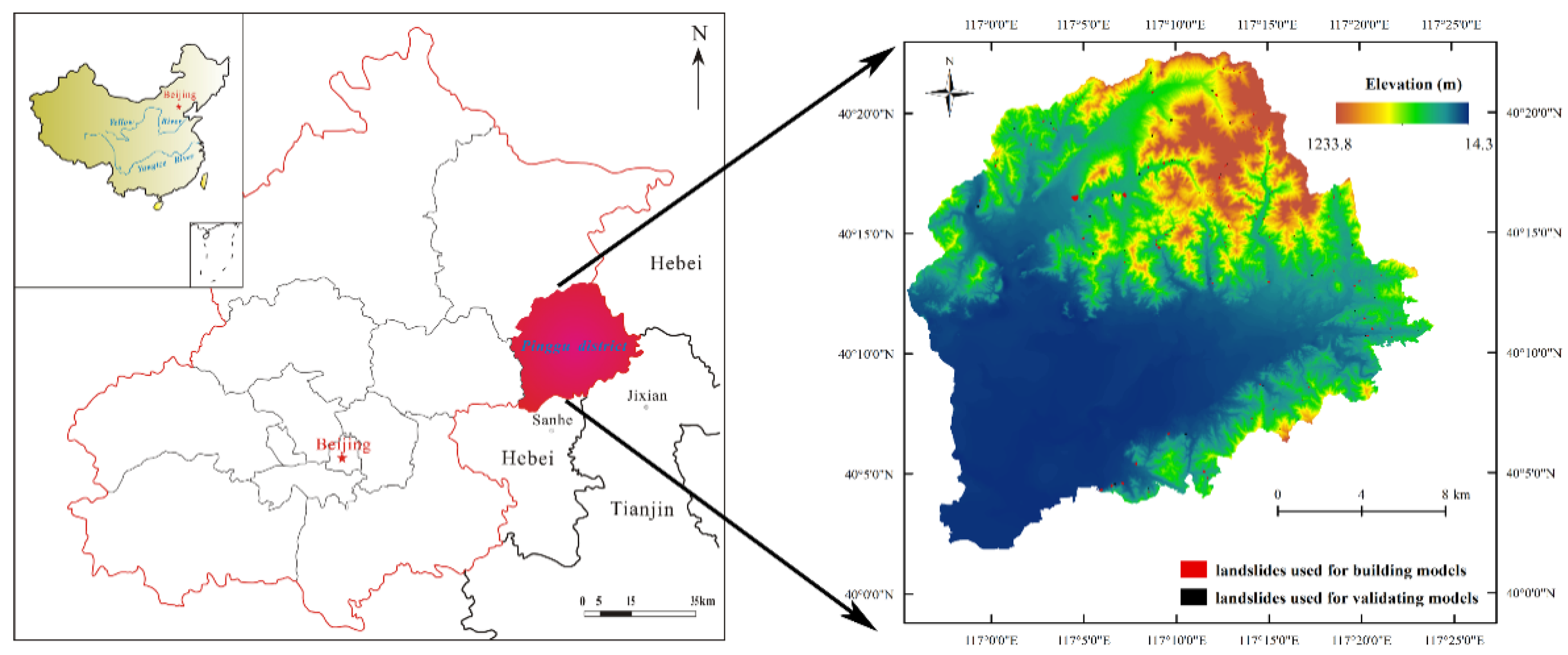

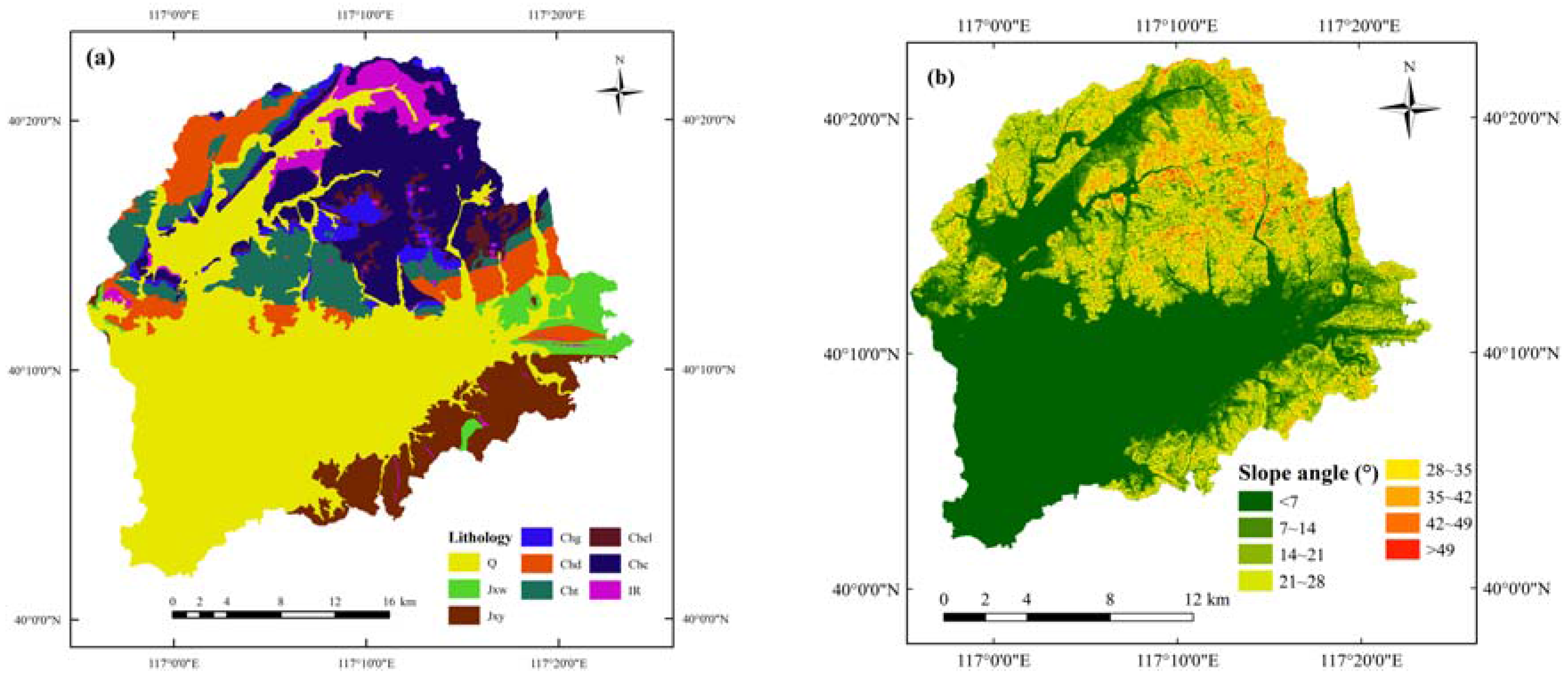
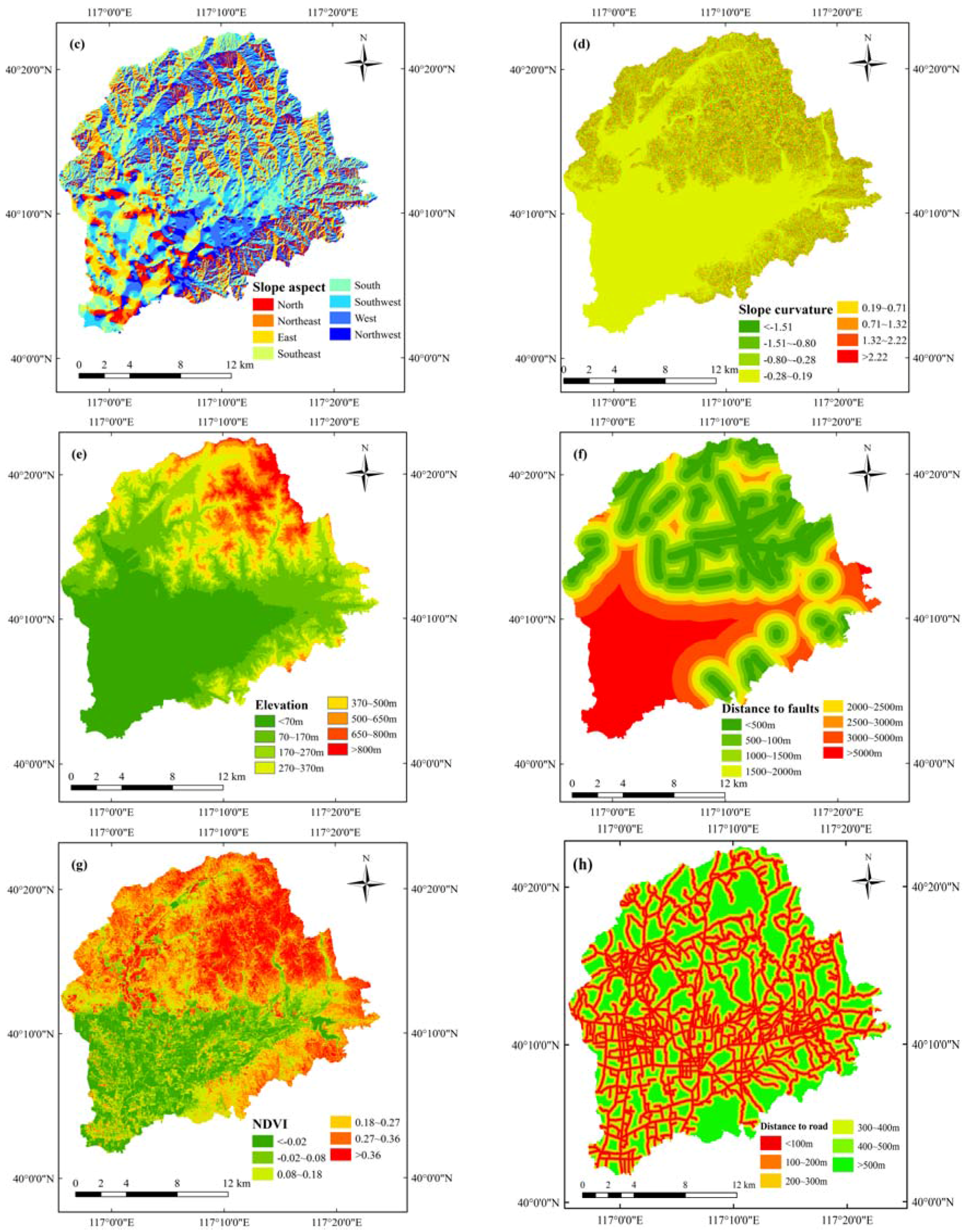
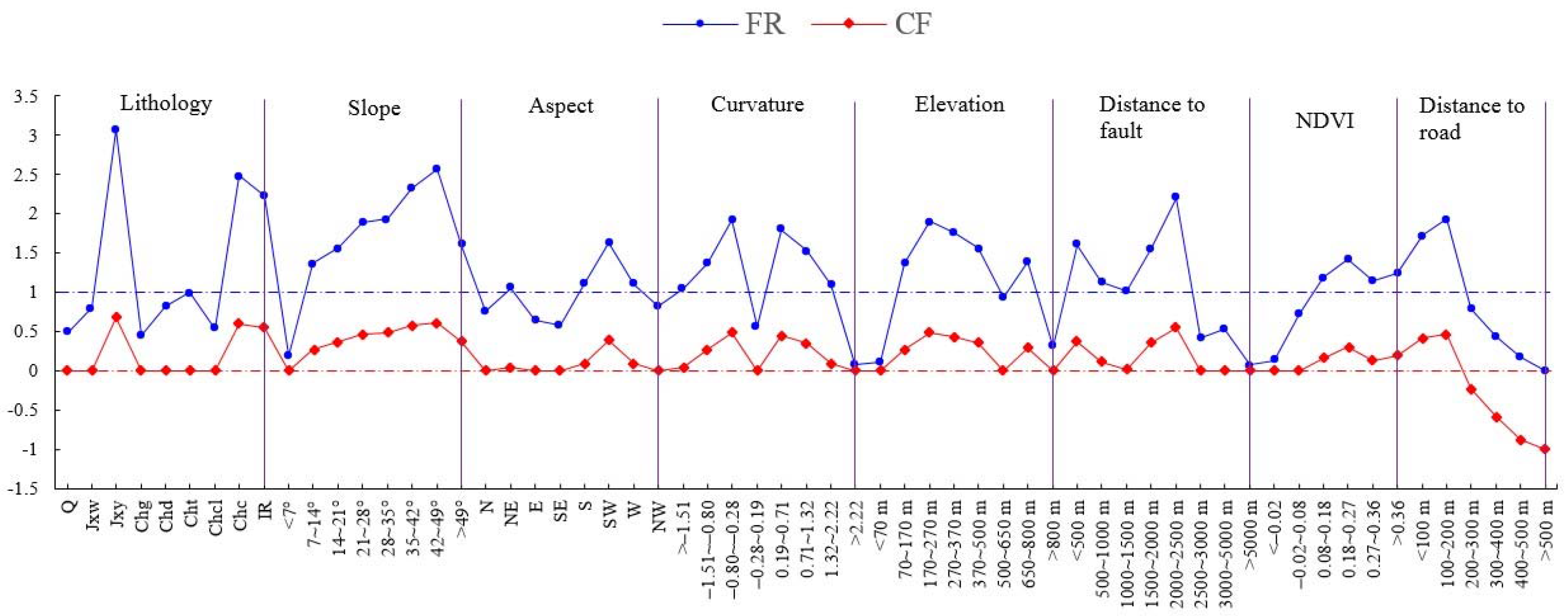
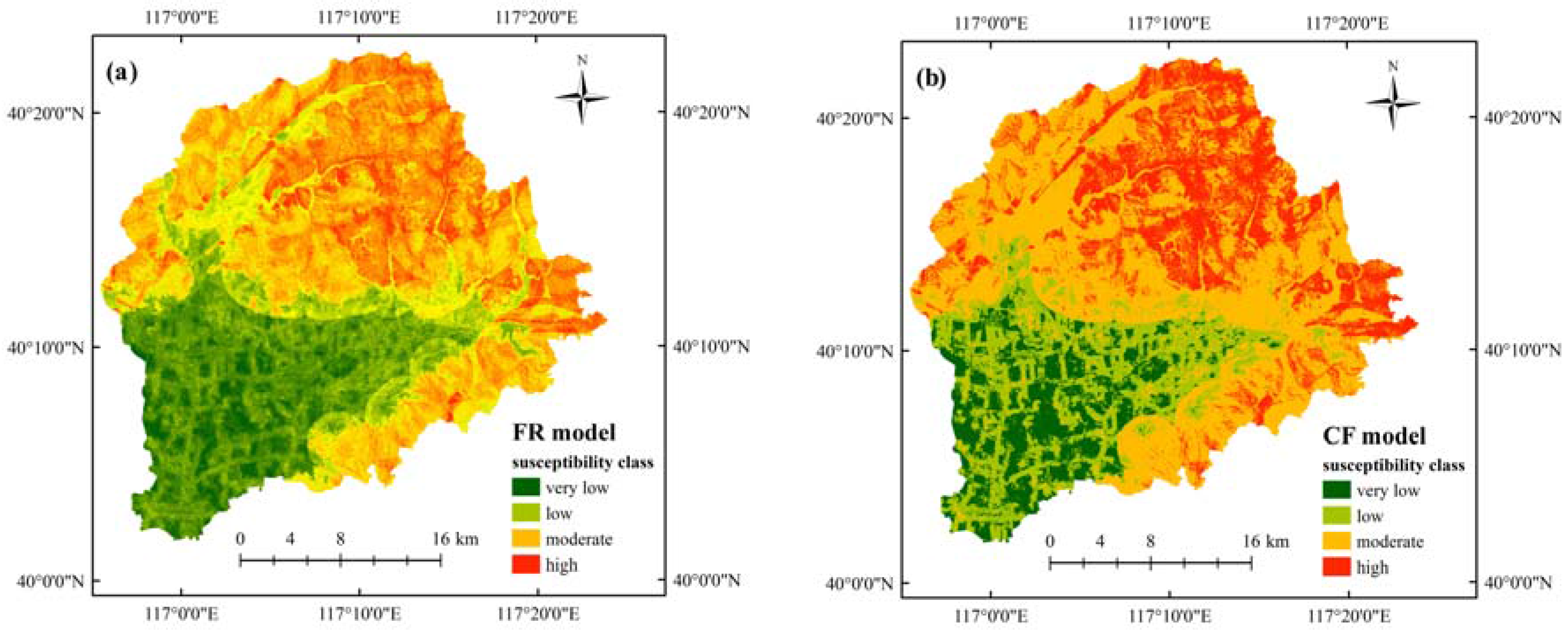
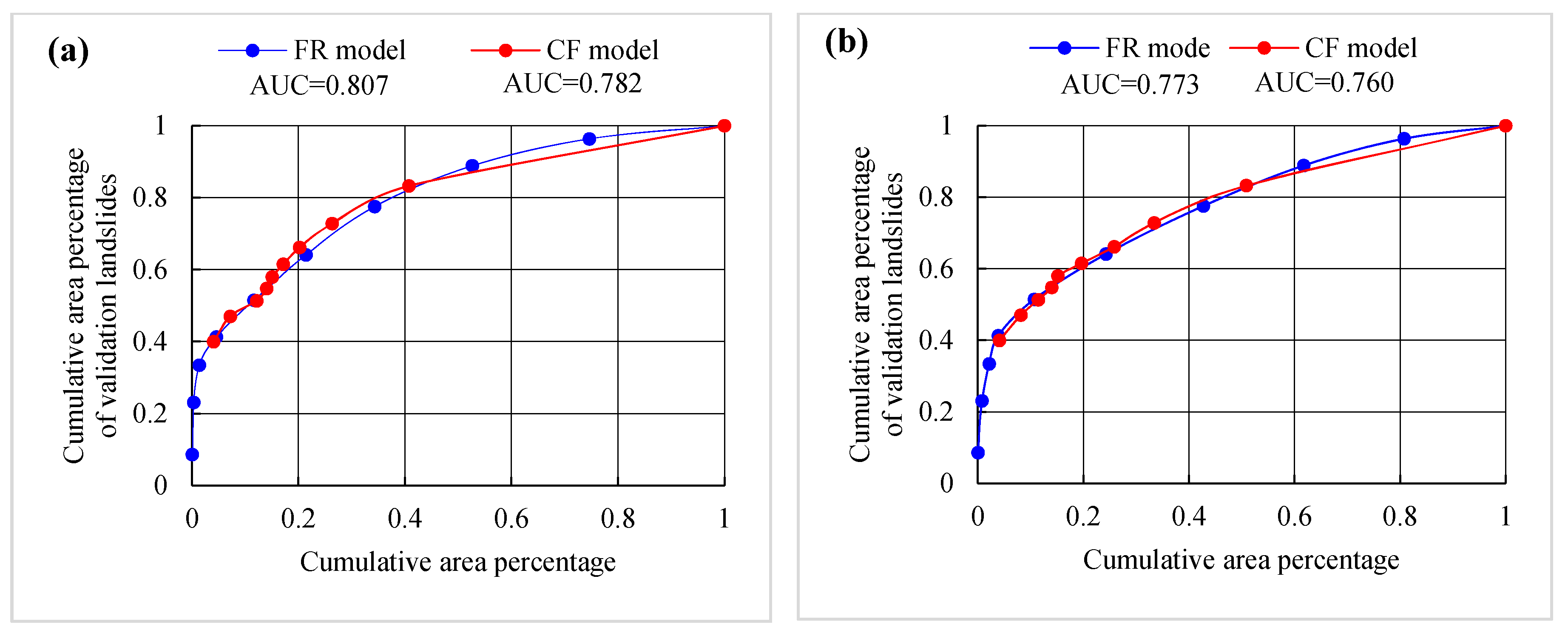
| Geological age | Formation | Lithology | Class |
|---|---|---|---|
| Cenozoic | -- | Quaternary deposits, gravelly soils. | Q |
| Proterozoic | Wumishan | Dolomite, silty dolomite, silty dolomite, argillaceous dolomite, shale. | Jxw |
| Yangzhuang | Conglomeratic dolomite, argillaceous and silty dolomicrite, carneule. | Jxy | |
| Gaoyuzhuang | Sandy dolomite, silty dolomite. | Chg | |
| Dahongyu | Dolomitic quartz sandstone, dolomicrite. | Chd | |
| Tuanzishan | Silty dolomicrite, dolomite, dolomicrite with siltstone and shale. | Cht | |
| Cuanlinggou | Lamellar sandy shale, dolomitic siltstone, dolomitic sandstone with silty shale. | Chcl | |
| Changzhougou | Silty shale, feldspathic quartz sandstone with siltstone, lenticular hematite. | Chc | |
| Archaeozoic | -- | Igneous rocks such as quartz monzonite, sillite, granite. | IR |
| Factor | Class | Npix(Ni,j) | Npix(Si,j) | PPa | PPs | FRi,j | CF |
|---|---|---|---|---|---|---|---|
| Lithology | Q | 512,803 | 413 | 0.0008 | 0.0017 | 0.4838 | −0.5166 |
| Jxw | 87,244 | 116 | 0.0013 | 0.0017 | 0.7988 | −0.2015 | |
| Jxy | 38,041 | 194 | 0.0051 | 0.0017 | 3.0638 | 0.6747 | |
| Chg | 80,374 | 60 | 0.0007 | 0.0017 | 0.4485 | −0.5519 | |
| Chd | 88,020 | 120 | 0.0014 | 0.0017 | 0.8190 | −0.1812 | |
| Cht | 31,522 | 52 | 0.0016 | 0.0017 | 0.9911 | −0.0090 | |
| Chcl | 23,553 | 21 | 0.0009 | 0.0017 | 0.5357 | −0.4648 | |
| Chc | 154,381 | 636 | 0.0041 | 0.0017 | 2.4750 | 0.5969 | |
| IR | 39,014 | 144 | 0.0037 | 0.0017 | 2.2174 | 0.5499 | |
| Slope | <7° | 506,984 | 158 | 0.0003 | 0.0017 | 0.1872 | −0.8130 |
| 7°~14° | 118,489 | 269 | 0.0023 | 0.0017 | 1.3639 | 0.2673 | |
| 14°~21° | 136,524 | 354 | 0.0026 | 0.0017 | 1.5578 | 0.3587 | |
| 21°~28° | 128,646 | 403 | 0.0031 | 0.0017 | 1.8820 | 0.4694 | |
| 28°~35° | 100,066 | 321 | 0.0032 | 0.0017 | 1.9272 | 0.4819 | |
| 35°~42° | 50,783 | 196 | 0.0039 | 0.0017 | 2.3187 | 0.5697 | |
| 42°~49° | 11,954 | 51 | 0.0043 | 0.0017 | 2.5631 | 0.6109 | |
| >49° | 1506 | 4 | 0.0027 | 0.0017 | 1.5957 | 0.3739 | |
| Aspect | N | 103,652 | 129 | 0.0012 | 0.0017 | 0.7477 | −0.2526 |
| NE | 91,548 | 160 | 0.0017 | 0.0017 | 1.0500 | 0.0477 | |
| E | 111,586 | 120 | 0.0011 | 0.0017 | 0.6461 | −0.3543 | |
| SE | 130,747 | 126 | 0.0010 | 0.0017 | 0.5790 | −0.4214 | |
| S | 167,337 | 308 | 0.0018 | 0.0017 | 1.1058 | 0.0958 | |
| SW | 164,646 | 445 | 0.0027 | 0.0017 | 1.6237 | 0.3848 | |
| W | 166,578 | 305 | 0.0018 | 0.0017 | 1.1000 | 0.0911 | |
| NW | 118,858 | 163 | 0.0014 | 0.0017 | 0.8239 | −0.1764 | |
| Curvature | >–1.51 | 22,004 | 38 | 0.0017 | 0.0017 | 1.0375 | 0.0362 |
| −1.51~−0.80 | 75,504 | 172 | 0.0023 | 0.0017 | 1.3686 | 0.2698 | |
| −0.80~−0.28 | 127,940 | 408 | 0.0032 | 0.0017 | 1.9159 | 0.4788 | |
| −0.28~0.19 | 600,592 | 553 | 0.0009 | 0.0017 | 0.5532 | −0.4472 | |
| 0.19~0.71 | 111,692 | 333 | 0.0030 | 0.0017 | 1.7911 | 0.4424 | |
| 0.71~1.32 | 73,454 | 186 | 0.0025 | 0.0017 | 1.5213 | 0.3432 | |
| 1.32~2.22 | 35,762 | 65 | 0.0018 | 0.0017 | 1.0919 | 0.0843 | |
| >2.22 | 8004 | 1 | 0.0001 | 0.0017 | 0.0751 | −0.9251 | |
| Elevation | <70 m | 383,802 | 67 | 0.0002 | 0.0017 | 0.1049 | −0.8953 |
| 70~170 m | 190,001 | 435 | 0.0023 | 0.0017 | 1.3754 | 0.2734 | |
| 170~270 m | 157,372 | 496 | 0.0032 | 0.0017 | 1.8935 | 0.4727 | |
| 270~370 m | 117,464 | 343 | 0.0029 | 0.0017 | 1.7543 | 0.4307 | |
| 370~500 m | 87,612 | 227 | 0.0026 | 0.0017 | 1.5566 | 0.3582 | |
| 500~650 m | 62,203 | 96 | 0.0015 | 0.0017 | 0.9272 | −0.0729 | |
| 650~800 m | 35,080 | 81 | 0.0023 | 0.0017 | 1.3872 | 0.2796 | |
| >800 m | 21,418 | 11 | 0.0005 | 0.0017 | 0.3085 | −0.6918 | |
| Distance to fault | <500 m | 186,708 | 496 | 0.0027 | 0.0017 | 1.5960 | 0.3740 |
| 500~1000 m | 157,821 | 296 | 0.0019 | 0.0017 | 1.1268 | 0.1127 | |
| 1000~1500 m | 133,401 | 225 | 0.0017 | 0.0017 | 1.0133 | 0.0131 | |
| 1500~2000 m | 104,352 | 268 | 0.0026 | 0.0017 | 1.5429 | 0.3525 | |
| 2000~2500 m | 79,364 | 290 | 0.0037 | 0.0017 | 2.1952 | 0.5454 | |
| 2500~3000 m | 57,988 | 40 | 0.0007 | 0.0017 | 0.4144 | −0.5860 | |
| 3000~5000 m | 133,762 | 117 | 0.0009 | 0.0017 | 0.5255 | −0.4749 | |
| >5000 m | 201,556 | 24 | 0.0001 | 0.0017 | 0.0715 | −0.9286 | |
| NDVI | <−0.02 | 174,033 | 38 | 0.0002 | 0.0017 | 0.1312 | –0.8690 |
| −0.02~0.08 | 133,598 | 160 | 0.0012 | 0.0017 | 0.7195 | −0.2808 | |
| 0.08~0.18 | 141,626 | 280 | 0.0020 | 0.0017 | 1.1877 | 0.1583 | |
| 0.18~0.27 | 226,641 | 534 | 0.0024 | 0.0017 | 1.4155 | 0.2940 | |
| 0.27~0.36 | 239,948 | 458 | 0.0019 | 0.0017 | 1.1467 | 0.1282 | |
| >0.36 | 139,106 | 286 | 0.0021 | 0.0017 | 1.2352 | 0.1907 | |
| Distance to road | <100 m | 291,382 | 833 | 0.0029 | 0.0017 | 1.7175 | 0.4145 |
| 100~200 m | 191,086 | 613 | 0.0032 | 0.0017 | 1.9273 | 0.4695 | |
| 200~300 m | 160,410 | 211 | 0.0013 | 0.0017 | 0.7902 | −0.2356 | |
| 300~400 m | 102,657 | 75 | 0.0007 | 0.0017 | 0.4389 | −0.5886 | |
| 400~500 m | 84,483 | 24 | 0.0002 | 0.0017 | 0.1707 | −0.8825 | |
| >500 m | 224,934 | 0 | 0 | 0.0017 | 0 | −1 |
© 2017 by the authors. Licensee MDPI, Basel, Switzerland. This article is an open access article distributed under the terms and conditions of the Creative Commons Attribution (CC BY) license (http://creativecommons.org/licenses/by/4.0/).
Share and Cite
Deng, X.; Li, L.; Tan, Y. Validation of Spatial Prediction Models for Landslide Susceptibility Mapping by Considering Structural Similarity. ISPRS Int. J. Geo-Inf. 2017, 6, 103. https://doi.org/10.3390/ijgi6040103
Deng X, Li L, Tan Y. Validation of Spatial Prediction Models for Landslide Susceptibility Mapping by Considering Structural Similarity. ISPRS International Journal of Geo-Information. 2017; 6(4):103. https://doi.org/10.3390/ijgi6040103
Chicago/Turabian StyleDeng, Xiaolong, Lihui Li, and Yufang Tan. 2017. "Validation of Spatial Prediction Models for Landslide Susceptibility Mapping by Considering Structural Similarity" ISPRS International Journal of Geo-Information 6, no. 4: 103. https://doi.org/10.3390/ijgi6040103





